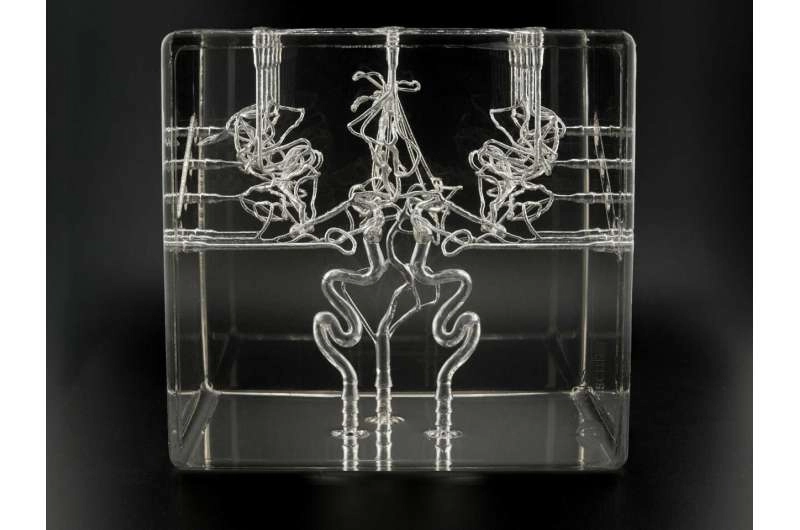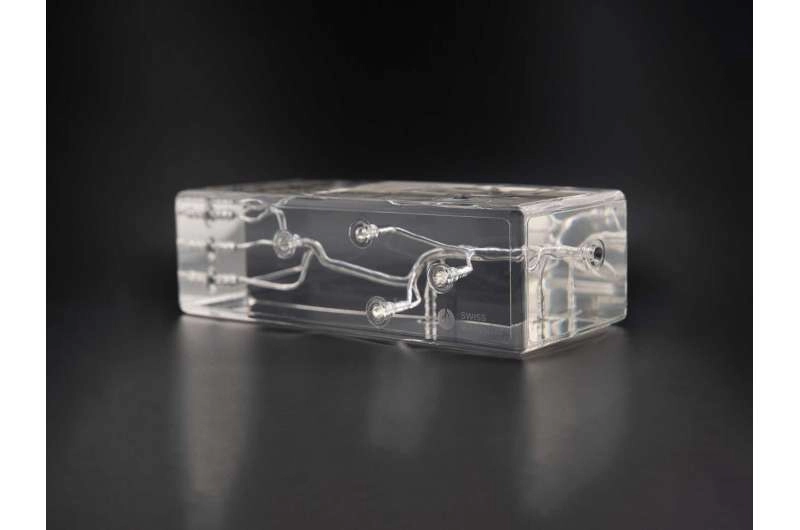 A model of a human brain, currently the most detailed available on the market. The smallest vessels are roughly 0.8 mm wide. Credit: Swiss Vascular
A model of a human brain, currently the most detailed available on the market. The smallest vessels are roughly 0.8 mm wide. Credit: Swiss Vascular
An ETH spin-off, Swiss Vascular, has developed anatomically exact silicone models of cerebral vessels. Through this development, researchers will not only reduce the amount of animal experimentation required but also improve the standard of medical training for complex medical procedures.
It all began with microcapsulestiny magnetic carriers designed to deliver medicine to precise locations in the body to help fight against cancer, for example. The key question was: how to safely direct these capsules through the body's complex vascular system?
Fabian Landers and Pascal Theiler, doctoral students at the Department of Mechanical and Process Engineering at ETH Zurich, found the answer not in the animal laboratory, where such things are usually tested, but in a 3D printed vascular model.
"The entire team spent days practicing on their models to gain as much insight as possible before conducting the planned animal experiments," recalls Theiler. "In the end, that preparation was a key contributor to the success of the experiments."
Their solution was developed by ETH researchers at the Multi-Scale Robotics Lab, which is led by Professor Bradley Nelson and Professor Salvador Pan� i Vidal. This has blossomed into a thriving spin-off with a clear mission: replace animal experimentation, where possible, and offer doctors the most realistic training conditions achievable.
Where silicone saves lives
Medical research accounts for a considerable amount of the animal experimentation conducted in Switzerland, particularly when it comes to developing and testing new therapies and medical devices. This often involves the use of large animals, such as pigs, dogs or primates.
Thanks to Swiss Vascular's silicone models, it is possible to practice procedures and test medical devices, thereby reducing the amount of subsequent animal experimentation required. In addition, researchers can learn more from existing experiments and increase their success rate, since a great deal has already been tested in the laboratory.
Unlike previous training models, Swiss Vascular's 3D printed models are made from advanced synthetic materials that closely mimic the elasticity of real tissue. One of the spin-off's unique selling points is the transparency of their models, allowing medical professionals to clearly observe the position of instruments during procedures.
Swiss Vascular's models are based on MRI and CT scans and replicate blood vessels in both the human brain and the brains of animals, such as pigs or sheep. "Every minute counts, especially when it comes to procedures on the brain, such as treating strokes. It is vital that doctors are able to train on accurate models and be as prepared as possible," explains Landers.
The two ETH mechanical engineers and their co-founder Oliver Brinkmann, also an ETH doctoral student, did not plan to launch a start-up: "It was simply necessary," says Landers. "We received numerous inquiries from researchers, clinics and even international partners." Swiss Vascular was officially launched in the summer of 2024.
Now, the young company is part of a larger network and works closely with ETH Zurich, University Hospital Zurich and the ETH 3R Hub. The 3R principlesReplace, Reduce, Refinepromote more ethical approaches to animal experimentation. Swiss Vascular's 3D models contribute to this approach by enabling the replacement of animal experimentation, minimizing the amount required, or to plan more precisely when there is no other alternative.
On 3R Day, which is taking place on 21 June at ETH Zurich, the team will demonstrate what such alternatives look like in practice. Visitors will have the opportunity to test the models themselves and discover firsthand where they are already being used in research, as well as what their limitations are.
 Model of a pig's facial vessels. Catheters are normally tested in these vessels, which are subsequently inserted into the human brain. Credit: Swiss Vascular
Model of a pig's facial vessels. Catheters are normally tested in these vessels, which are subsequently inserted into the human brain. Credit: Swiss Vascular
As a spin-off, Swiss Vascular wants to do more than just build models for research. The three founders aim to develop a comprehensive simulation platform that will allow medical professionals to regularly practice complex procedures in as realistic a setting as possible, without risk to patients or lab animals.
While this vision is still some way off, the demand is high and the market is substantial. Yet, there are still challenges to overcome. "You suddenly need to deal with things like certification, contracts and financesareas far removed from the world of research," says Theiler. Nevertheless, their commitment to driving changes prevails: a change for research, for the clinics and, ultimately, for patients.
Citation: Practicing medicine on a lifelike silicone model of cerebral vasculature (2025, June 16) retrieved 16 June 2025 from https://medicalxpress.com/news/2025-06-medicine-lifelike-silicone-cerebral-vasculature.html
This document is subject to copyright. Apart from any fair dealing for the purpose of private study or research, no part may be reproduced without the written permission. The content is provided for information purposes only.




